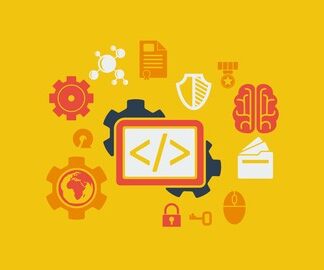
If you find yourself needing assistance at any point throughout the tutorial series, feel free to enroll in The Complete Ethical Hacking Course Bundle for 1 on 1 help!
https://josephdelgadillo.com/ethical-hacking/
Below is a list of the courses included in the bundle:
The Complete Ethical Hacking Course for 2018!
http://bit.ly/2leW0j4
Certified Ethical Hacker Boot Camp for 2018!
http://bit.ly/2yKbler
The Complete Ethical Hacker Course: Beginner to Advanced!
http://bit.ly/2i3kirq
Build an Advanced Keylogger for Ethical Hacking!
http://bit.ly/2yMl3gI
Hello everybody and welcome to this tutorial. Today, I will introduce you to the Linux terminal and show you some of its basic functionalities.
In Kali Linux, the terminal icon is located in the upper left corner. So just click on it, and there you go. You have the terminal up and running. By default, it will open up a root terminal in Kali. You don’t actually need to do anything else to get started, however 99% of the time people will configure the terminal to suit their own needs and purposes. For example, I will almost always increase the font size so that it’s clear and visible, and so that I have a better view of what I am doing. It is also said that this can reduce eyestrain. Anyway, just go ahead and right-click anywhere on the terminal itself, and then you have show menu bar. Go ahead and click on edit. You can click on profiles as well and create new profiles here by just clicking on new, giving it a name, and then configuring it in the preferences. We’re going to be configuring the default profile since there really is no need to create any additional ones. Go ahead and click on profile preferences, and here you have a great number of options. One of the first ones that you will see is that you can use a system fixed width font. This is not good. As you can see, this is very small. I always need to change this. I have mono space 20. If you click on it, you can change the font size here, if you wish. You have some other very simple options here. You have show menu bar by default in new terminals. I generally click it. You have the cursor shape here. So you have a block and you have an underline. I prefer a block, but you can use whatever you wish. You have title and command. We don’t actually need to change anything there. We have colors. So, I think that this color scheme is appropriate and fitting for me, but you can change it any way you like. You can change the text color, the background color, you have the color pallet here, so you can do whatever you would like here. You have built-in schemes, so it says white on black. I can say green on black. Does it have blue on black? Oh, this is bad. I wouldn’t be able to work with this combination. So, let’s just leave it on white on black. This is one of the best color schemes. Personally, I use blue on black with Fedora, but I’m just going to leave it as it is here. No need to actually change anything. Now in background you have three features. You have a solid color like this one here, and you can choose a background image. You can download anything you would like from the internet, you can configure it to be transparent or image background, and you also have the ability to have a fully transparent background. If you click on transparent background, it’s pretty much the same as having a background image. I’m just going to configure the transparency levels, and that’s pretty good. Except, in this case your background image will be your desktop image, depending on where your terminal window is. In scrolling there’s an important feature here, it’s scroll back. So, if you don’t want to be limited to 512 lines, you want to go ahead and click on unlimited, unless you’re severely limited in terms of RAM. In any case, it’s better to have the full output displayed. You don’t need to do anything here in terms of compatibility. I’m just going to go ahead and close this. I have selected a transparent background, and you see this only works for a desktop image. It doesn’t actually show icons, or anything of a kind. If I open up my web browser it’s not going to show it in the background, it’s still going to keep the desktop background image, so the desktop wallpaper. There’s a slight delay when it goes about updating, but that’s fine.
In any case, you can go ahead and click on file, and open tab. I’m going to go ahead and open myself four tabs, three new ones, and one that I already had opened. So here you can switch in between them. For example, if I press open up a new terminal, I have to click here, and then I have to click here, I just want to show you what it’s like to have four individual windows. So, yeah, this can be difficult to manage, especially because you don’t know what actions you are performing in each terminal. People sometimes split their screens into terminals. I sometimes do that, it’s very nice, but we will deal with that a bit later on when we get into some serious stuff, when we actually need multiple terminals. But, tabbing these terminals is very nice, primarily because you can actually see what you’re doing on each one of them in the header. See these things that I’m selecting, that I’m clicking on now? They’re the headers of the terminal. If, for example, in this terminal I want you to go into home, change directory to home, and if I change it here to var, and if I change it here to var/logs, and if I want to go here to tmp folder, excellent! So, on each of these tabs, in their headers, I can see where I am. So this one it’s home, this one is tmp, I don’t need to click on it to know. This one is log, so I can know what I’m doing in each particular terminal. And even though you can have a program running, or something like that, it’s still going to write it out in the header, and you’re going to get some extra information there. It’s very nice, very useful, and it’s going to help you out a lot as we progress through this course, and as we get into more complicated topics.
Anyway, I just wanted to introduce you to the Linux terminal. We have done some work with it before during the installation of VirtualBox, and VirtualBox guest additions, but basically there I’ve just given you the command, and you were just rewriting it, or copy/pasting it. In the follow up tutorial, I will start explaining the fundamental Linux terminal commands, the most common ones, the basic ones, and there you will be able to see the logic of things, and how this Linux terminal works and functions. Once you actually learn that, it gives you a huge amount of power. All the power of the operating system rests on it’s terminal, because it’s a direct interface to the kernel of the system, and it’s a lot faster than the graphical user interface. One more key note that I would like to make here, once I teach you how to use the Linux terminal, and once you get into the habit of typing in commands, you can use them for a wide variety of purposes. You don’t necessarily need to use these things for pen-testing, or something like that, you can use these commands for network administration, or you can use them in order to troubleshoot problems with the system, and so on and so forth. So you get a far wider spectrum of options in terms of jobs, as opposed to just learning pen-testing applications. In any case, I bid you farewell, and I hope to see you in the next tutorial.
The remainder of the tutorial videos can be found in this YouTube playlist:
You can also enroll in the course and download the videos for offline viewing:
https://jtdigital.teachable.com/p/hacking-free/
Subscribe on YouTube – https://www.youtube.com/c/JosephDelgadillo?sub_confirmation=1
Follow on Steemit – https://steemit.com/@jo3potato









